Related Research Articles
The Funbo runestones constitute a group of four runestones originally from Funbo in the province of Uppland, Sweden, which were raised by members of the same family during the eleventh century.
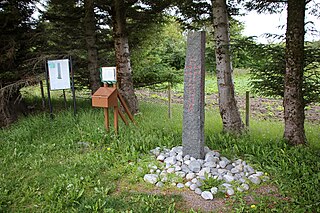
The Kulisteinen, also known as the Kuli stone and listed as N 449 in the Rundata catalog, is a stone with a runic inscription that was originally located at Kuløy in Smøla municipality, Norway.

The Skarpåker Stone, designated by Rundata as Sö 154, is a Viking Age memorial runestone that originally was located in Skarpåker, Nyköping, Sörmland, Sweden. It dates to the early eleventh century.
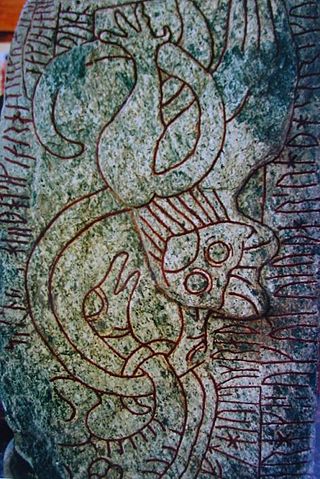
The Sparlösa Runestone, listed as Vg 119 in the Rundata catalog, is located in Västergötland and is the second most famous Swedish runestone after the Rök runestone.

The Jarlabanke Runestones is the name of about 20 runestones written in Old Norse with the Younger Futhark rune script in the 11th century, in Uppland, Sweden.

Tryggevælde Runestone, designated as DR 230 under Rundata, is a runestone housed in the National Museum of Denmark, in Copenhagen. It is classified as being carved in runestone style RAK, and is dated to about 900 CE.
The Ingvar runestones is the name of around 26 Varangian Runestones that were raised in commemoration of those who died in the Swedish Viking expedition to the Caspian Sea of Ingvar the Far-Travelled.

The Tillinge Runestone, designated as U 785 under Rundata, is a Viking Age memorial runestone that was found at the church of Tillinge in Uppland, Sweden.
The England runestones are a group of about 30 runestones in Scandinavia which refer to Viking Age voyages to England. They constitute one of the largest groups of runestones that mention voyages to other countries, and they are comparable in number only to the approximately 30 Greece Runestones and the 26 Ingvar Runestones, of which the latter refer to a Viking expedition to the Caspian Sea region. They were engraved in Old Norse with the Younger Futhark.

The Varangian Runestones are runestones in Scandinavia that mention voyages to the East or the Eastern route, or to more specific eastern locations such as Garðaríki in Eastern Europe.
The Viking runestones are runestones that mention Scandinavians who participated in Viking expeditions. This article treats the runestone that refer to people who took part in voyages abroad, in western Europe, and stones that mention men who were Viking warriors and/or died while travelling in the West. However, it is likely that all of them do not mention men who took part in pillaging. The inscriptions were all engraved in Old Norse with the Younger Futhark. The runestones are unevenly distributed in Scandinavia: Denmark has 250 runestones, Norway has 50 while Iceland has none. Sweden has as many as between 1,700 and 2,500 depending on definition. The Swedish district of Uppland has the highest concentration with as many as 1,196 inscriptions in stone, whereas Södermanland is second with 391.
The Baltic area runestones are Viking runestones in memory of men who took part in peaceful or warlike expeditions across the Baltic Sea, where Finland and the Baltic states are presently located.

The Manx runestones were made by the Norse population on the Isle of Man during the Viking Age, mostly in the 10th century. Despite its small size, the Isle of Man stands out with many Viking Age runestones, in 1983 numbering as many as 26 surviving stones, which can be compared to 33 in all of Norway. So many of them may appear on the Isle of Man because of the merging of the immigrant Norse runestone tradition with the local Celtic tradition of raising high crosses.

The Mejlbystenen, also known as runic inscription DR 117 from its Rundata catalog listing, is an approximately 1,000-year-old runestone originally located at Mejlby, near Randers in Denmark. According to a new interactive exhibit of the stone at the Randers Kulturhistoriske Museum, which differs slightly from the accepted Rundata translation, the stone reads:
Åne erected this stone for his son Eskil who found death with Thore in Øresund
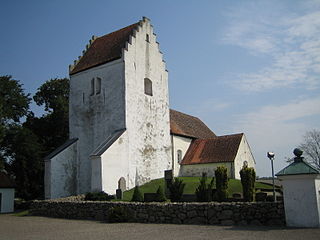
The Skårby Runestones are two Viking Age memorial runestones originally located in Skårby, which is about ten kilometers northwest of Ystad, Scania, Sweden.
The Bjärby Runestones are two Viking Age memorial runestones located near Grästorp, Sweden, in Bjärby synod, which was in the historic province of Västergötland. The two stones are memorials to men who held the titles thegn and drengr, and one has a depiction of the hammer of the Norse pagan deity Thor.
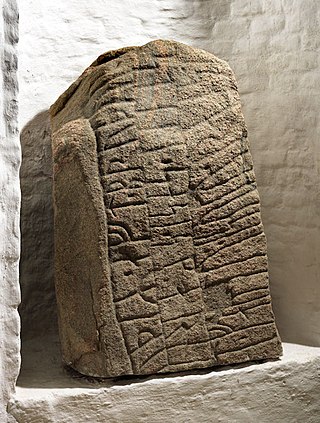
The Egtved Runestone or DR 37 is a Viking Age runestone engraved in Old Norse with the Younger Futhark runic alphabet. It was discovered in 1863, by a master mason named Anders Nielsen from Starup, in the southern part of the cemetery of Egtved church. It is dated to the period 900–1020. The stone is in granite and measures 80 cm in height, 55 cm in width and 43 cm in thickness. The style of the runestone is the runestone style RAK.

The Stangeland stone or N 239 is a Viking Age runestone engraved in Old Norse with the Younger Futhark runic alphabet in Stangeland, Norway, and the style of the runestone is the runestone style RAK. It was found on Stangeland Farm, where it has been moved several times and for many years was used as a bridge over a river.
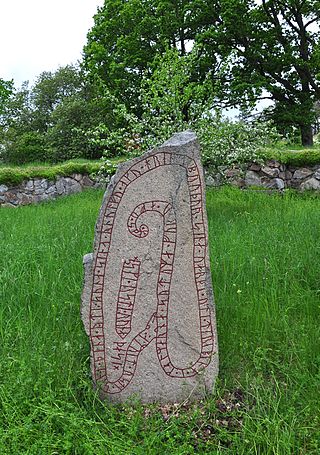
The Södermanland Runic Inscription 333 is a Viking Age runestone engraved in Old Norse with the Younger Futhark runic alphabet. It is located at the abandoned Ärja Church in Strängnäs Municipality. The style of the runestone is a categorized as Fp.

The Uppland Runic Inscription 258 is a Viking Age runestone engraved in Old Norse with the Younger Futhark runic alphabet. It is in granite and located at Fresta Church in Upplands Väsby Municipality.
References
- 1 2 Spurkland, Terje (2005). Norwegian Runes and Runic Inscriptions. van der Hoek, Betsy (trans.). Woodbridge: Boydell Press. pp. 91, 117. ISBN 1-84383-186-4.
- ↑ Cleasby, Richard; Vigfússon, Guðbrandur (1878). An Icelandic-English Dictionary. Clarendon Press. pp. 197.
- ↑ Project Samnordisk Runtextdatabas Svensk - Rundata entry for N 225.